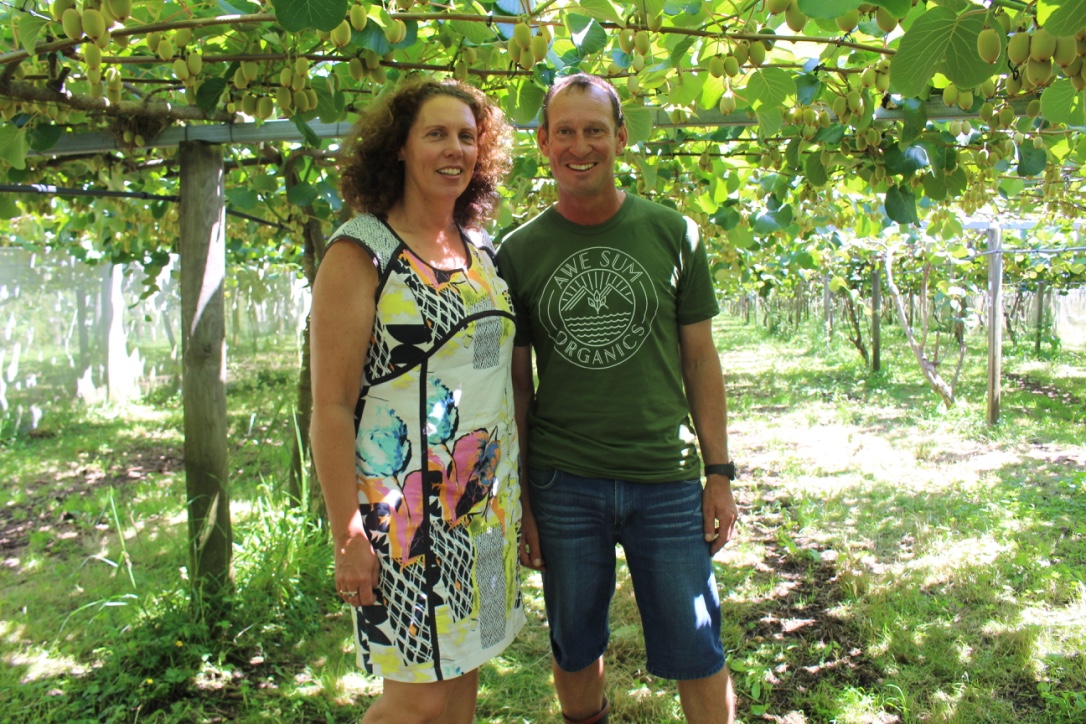Ten years ago, while looking for a new challenge, Catriona and Mark White compiled a five-point list to guide them on a quest to create an improved lifestyle for their young family. “We didn’t know where we wanted to live in New Zealand, or exactly what we wanted to be doing,” says Mark, who at the time was Operations Manager for NZ Post in Auckland, while Catriona was a busy mum to two children under five. Being able to spend more time with daughter Letisha and son Lochlan, while living in a coastal location with good education opportunities, the opportunity to run a profitable family business and enable their children to gain financial literacy skills were all on that list. In 2007, the family found the embryonic answers to their wishes when Catriona’s parents offered the couple the chance to buy part of an organic dairy farm near Opotiki to develop as a kiwifruit orchard. “My family has been farming this land for four generations, and our children are the fifth generation to live here,” says Catriona. “For most of that time the land has been farmed using organic principles.” Learn by mistakes The couple, who knew little about kiwifruit, had some initial family assistance with planning and then decided to do most of the physical development work themselves, keeping down costs and “learning by our mistakes”. Mark enrolled in what he calls “kiwifruit school” - a polytechnic course to gain the National Certificate in Horticulture. “It was great,” he says, “as the skills I learned complimented what was happening on our orchard, including grafting which we learned on the course at the same time as we were doing it on the orchard.” With a clear vision to grow kiwifruit organically, the couple planted Cryptomeria Japonica (Japanese Cedar) and Casuarina Cunningham shelter trees. “Both are excellent shelter and were chosen because pests such as scale do not live in either of them.” The orchard’s soils are predominantly Opotiki Sandy Loam, which is free draining and its top soil encourages root growth. “Our strategy during the development of the orchard has been to minimise earthworks in order to minimise damaging our soil structure. “In situations where earthworks have been completed in order to re-shape the land for orchard use, the strategy has been to put the cows back into that area for a few years to assist with replenishing the soil biology that gets disturbed.” Grafting SunGold Initially Hayward Green and Hort16A gold kiwifruit were grafted onto Bruno rootstock, but when Mark and Catriona saw the devastation caused by the vine disease Psa-V, first identified in Te Puke in 2010, they decided to remove the gold vines, growing organic passion fruit to provide some income until the newly grafted G3 vines came into production. “On reflection, grafting to G3 is the best thing we could have done as the variety is well suited to growing organically as it produces good sized fruit. We struggled with fruit size when growing Hort16A,” says Mark. Today the orchard has 3.19 ha of Zespri Organic Green kiwifruit, producing in 2017 a total of 23,483 trays of kiwi-start fruit. Zespri Organic SunGold (G3) is currently grown on 2.65 ha, producing 38,362 trays. This production was achieved in a “challenging growing year” which included various cyclones and a very wet and windy autumn. Recently developed blocks of SunGold are coming into production during the upcoming season. Native birds A small flock of certified organic sheep carry out weed control duties around the sides of the orchard, helping reduce tractor work and its associated soil compaction, especially in winter. Pest management is based on eliminating as many host plants as possible from the perimeter of the orchard and organic sprays are used as required, to disrupt pests’ life-cycles. However, there are other “unpaid pest patrol” at work in the orchard, including native weka and fantail who prey on insects. Bird seed plants are also grown to encourage birds away from eating kiwifruit flower buds. Even slugs are welcome living in what Mark calls “slug hotels” - large clumps of grass beneath the vines. “Slugs assist in recycling organic material on the floor of the orchard and provide a source of food for birds. With plenty for the slugs to eat on the ground, they didn’t bother to chew on the newly grafted vines.” Live in balance Mark and Catriona believe everything within the environment is striving to live. “Even Psa just wants to live, so it’s a matter of finding the point at which everything can live in balance.” Letisha, now 14, and Lochlan, 13, have been involved in the orchard since they were pre-schoolers and now have their own “mini orchard block” to manage. With Catriona and Mark’s guidance, and a little physical help, they plan and carry out the orchard work and receive any profit their fruit has made after all expenses are paid. The bare land the Whites bought in 2007 fell short of meeting every item on their wish list. Thanks to their hard work, support and encouragement from family and industry professionals, today the orchard and the lifestyle Catriona and Mark have created more than ticks every one of those five points.
Wednesday, April 24, 2024
Posted: 11:54am Wednesday 14 Feb, 2018 | By Elaine Fisher elaine@thesun.co.nz
Five-point wish list a reality – 10 years on

Catriona and Mark White


0 Comments
Leave a Comment